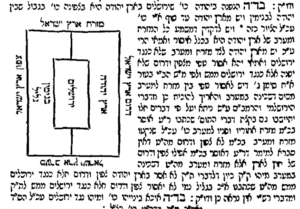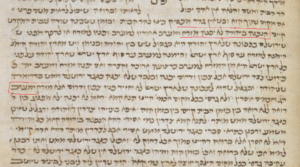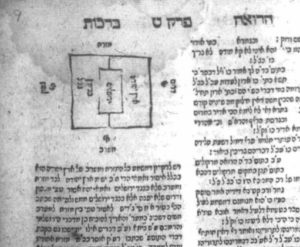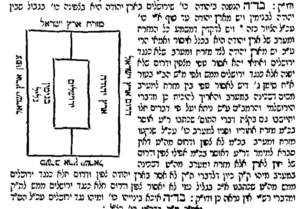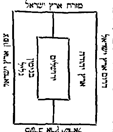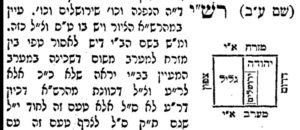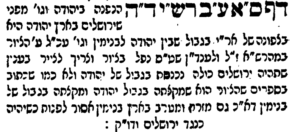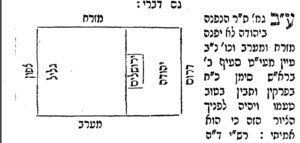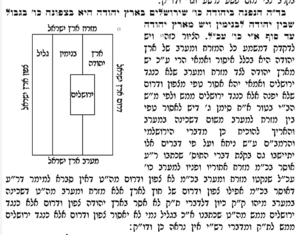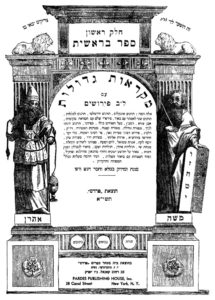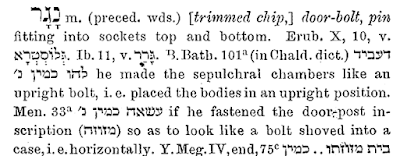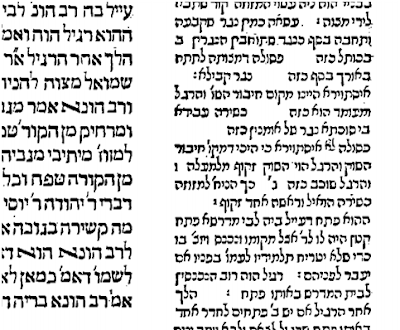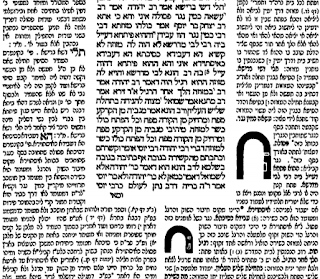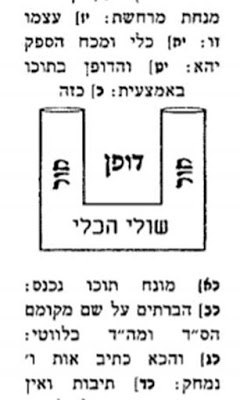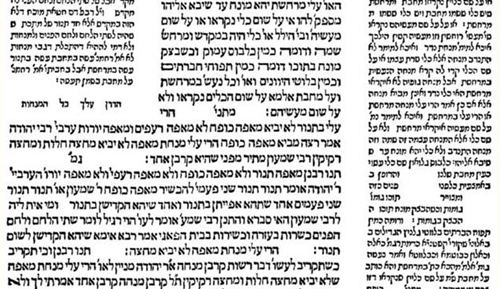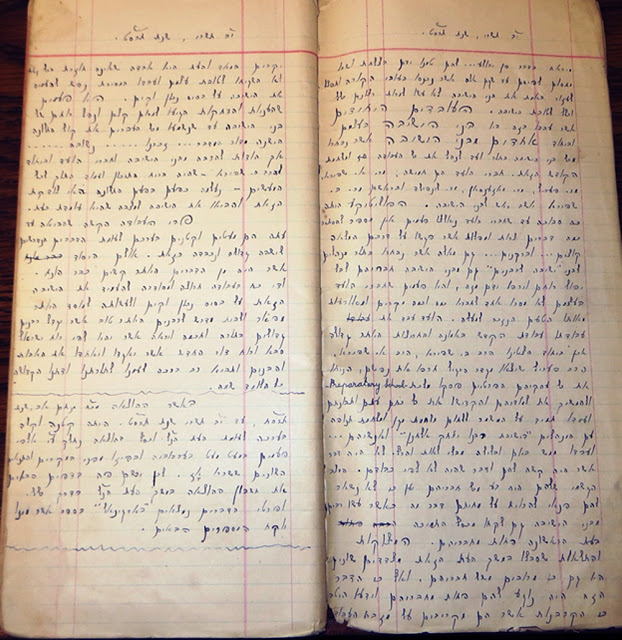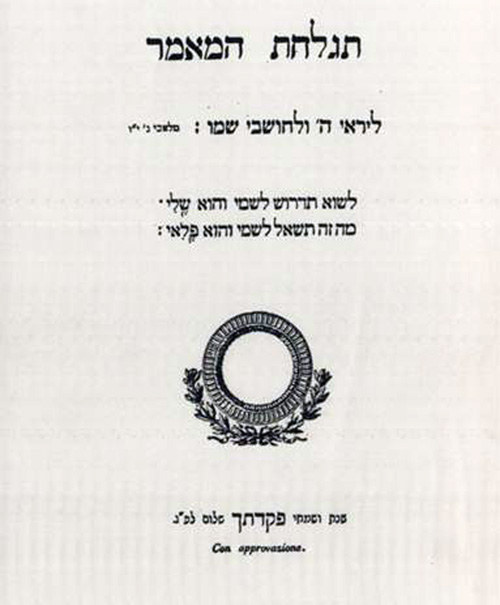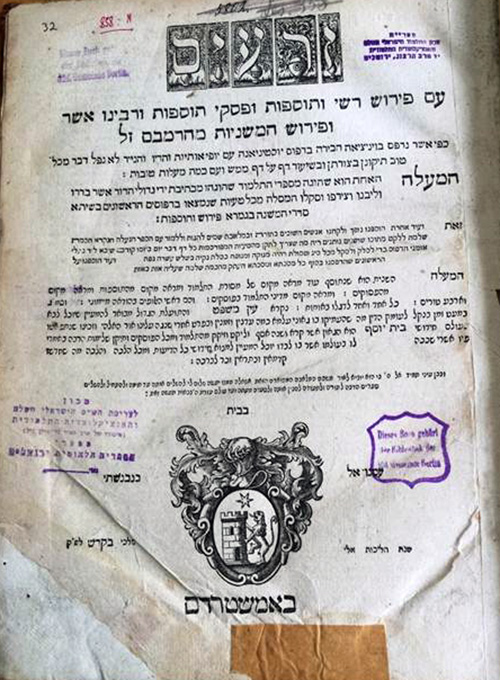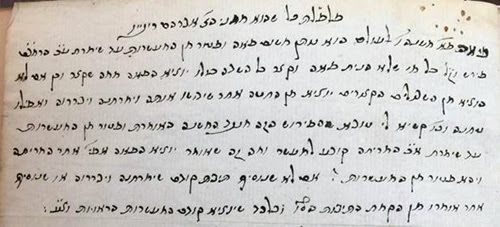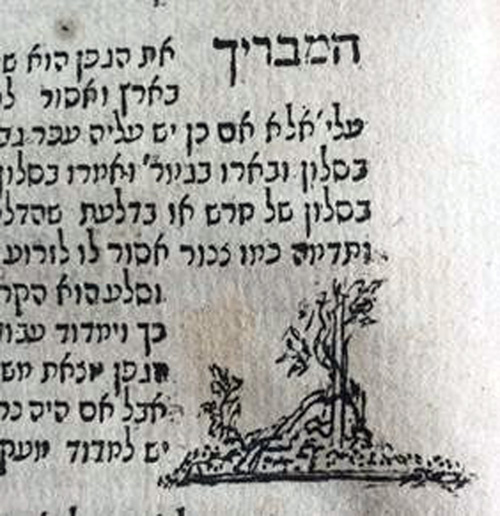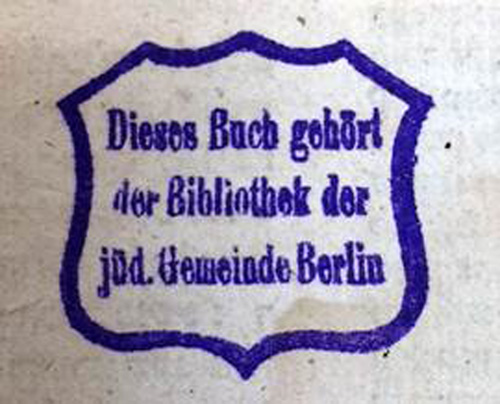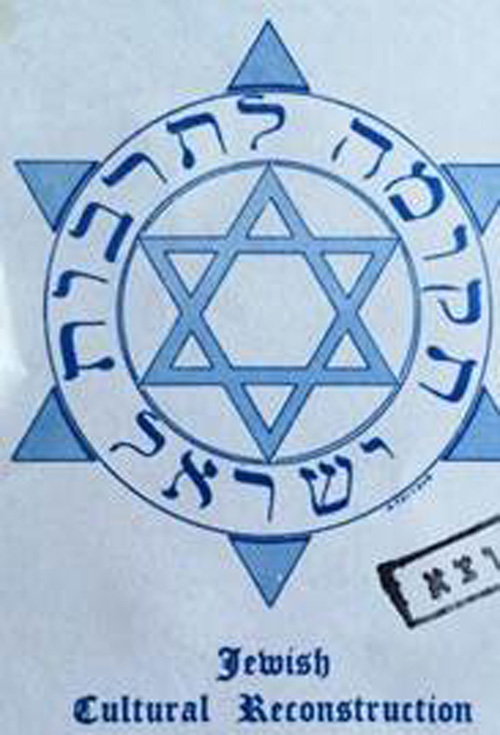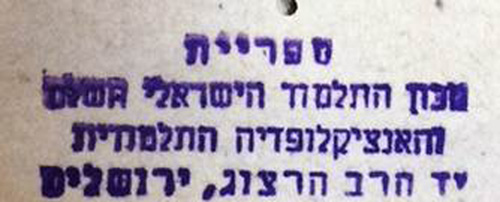The Strange Shape
of the Marcheshet Pan
By Eli Genauer
“The underlying basis of our work is that
pictures are an organic part of the commentary, and it possible that Rashi even
allowed himself to limit his explanatory words when a picture was available to
the reader. This is in the sense of “a picture is worth a thousand
words”. The picture is an integral part of the written book, no less
important than the words.”
Dr Ezra Chwat
Department of Manuscripts, National Library of Israel
Giluy Milta B’Almah Blog
January 15, 2017
There were many vessels
used in the Beit HaMikdash. Nevertheless, without pictures or diagrams drawn
contemporaneous to their existence, there remains some doubt as to exactly what
they looked like. I would like to discuss one vessel used quite often in the
Temple and see what the diagrams of the Rishonim can tell us about its makeup.
I would also like to analyze a diagram in Rashi’s commentary to Talmud Bavli
and see how it fits into our discussion.
Massechet Menachot 63a
האומר הרי עלי במחבת, לא יביא במרחשת; במרחשת, לא יביא במחבת. מה בין מחבת למרחשת–אלא שהמרחשת יש לה כסוי, ולמחבת אין לה כסוי, דברי רבי יוסי הגלילי; רבי חנניה בן גמליאל אומר, מרחשת עמוקה ומעשיה רוחשין, ומחבת צפה ומעשיה קשין
One who says, “I take upon myself [to offer a grain offering prepared]
on a griddle, he must not bring [one baked] in a pan. If [he says “I take upon
myself to offer a grain offering prepared] in a pan,” he must not bring [one
prepared] on a griddle. What is the difference between a griddle and a pan? The
pan has a lid to it, but the griddle has no lid – [these are ] the words of
Rabbi Yose Hagili; Rabbi Hanina ben Gamliel says : a pan is deep and what is
prepared is spongy, a griddle is flat and what is prepared is hard.[1]
Leaving aside the opinion of Rabbi Yossi Haglili, let us concentrate on the statement of Rabi Chanina ben Gamliel
We would imagine that the Marcheshet is a deep vessel, and the Machvat
is flat, as it is described as a griddle.
Perhaps like this:
The Gemara then cites a Braita which deals with the following
situation. If a person takes a vow
saying “I take upon myself a Marcheshet”, it remains unclear whether he meant
he will bring the vessel called a Marcheshet, or the normal Korban Mincha that
is brought in a Marcheshet. Beit Hillel is of the opinion that since there was
a specific vessel in the Beit Hamikdash called a Marcheshet, we understand that
he is talking about that vessel and we require him to donate it to the Beit
HaMikdash.[2] Here are the words of the Braita which describe in some detail
the appearance of this Marcheshet pan:
כלי היה במקדש ומרחשת שמה ודומה כמין כלבוס עמוק וכשבצק מונח
בתוכם דומה כמין תפוחי הברתים וכמין בלוטי היוונים
There was a vessel in
the Temple called Marhesheth, resembling a deep mould, which gave the dough
that was put into it the shape of Cretan apples and Grecian nuts. (The Soncino
Hebrew/English Babylonian Talmud)
Rashi goes to great
lengths to explain this uncertain statement and includes a diagram in his commentary.
This diagram first appeared in printed form in the early 18th
century but unfortunately, it does not align with the words Rashi uses to
describe the overall shape of the pan.
Additionally, It does not match the diagram we have in a manuscript of
Rashi nor diagrams in manuscripts of other Rishonim.
But first some
background
The diagrams we have
today in the Vilna Shas in Rashi and other Rishonim come from earlier printed
editions. The first printed edition of the entire Talmud to contain diagrams
was the Behrmann Shas printed in Frankfurt on Oder, 1696-98.[3] Raphael Natan
Nata Rabinowitz posits that by the time diagrams were included in the printed
text, there were very few manuscripts around because most had been placed in
Genizah.[4] He therefore concludes that manuscripts were not used in the early
18th century as a source for diagrams. What was the source of those
diagrams for the Behrmann Shas ? According to the editors of the Behrmann Shas,
they mostly came from the Chochmat Shlomo of 1582.[5] It’s an extremely
reliable source because it was written by Rav Shlomo Luria who specifically
wrote it to correct the text of the Bomberg Shas and to insert the relevant
diagrams. Rav Shlomo Luria lived at a time when there were still many
manuscripts around, so either he used those manuscripts for his textual
emendations and as a source for his diagrams, or he used his own capabilities
to come up with his changes and additions. Since most of our present day
diagrams follow from the Behrmann edition, they have an aura of authenticity
attached to them.[6]
The problem arises when
we discover that Chochmat Shlomo does not include all the diagrams we have
today. For example, in our case, there is no Chochmat Shlomo on Menachot.
Let us now take a look
at the diagram in Rashi on Menachot 63a.
The first time it
appeared in print was in the Frankfurt am Main edition of 1722, exactly 200
years after the diagramless Bomberg edition. We know its source was not a
manuscript of Rashi nor was it the product of the Maharshal.
Putting aside the
diagram for a moment, let us concentrate on the words of Rashi as he tries to
describe the Marcheshet:
כלבוס
– גלואו”ן שם כלי עשוי כעין מחבת שלנו והדופן באמצעות כלפי פנים
כזה ומצוייר תוכו גומות גומות וכשהבצק מונח בתוכו [נכנס] הבצק
בגומות:
Rashi concentrates on
the word כלבוס as the Gemara itself says that a Marcheshet is shaped like a
deep כלבוס. Rashi first gives us an old French word
which is normally translated as “tongs”.[7] He says that the Marcheshet is like
his present day Machvat pan and that the “wall in the middle faces the inside,
like this”. The problem is that the diagram does not seem to show a wall in the
middle facing the inside. Additionally, if a כלבוס is a pair of tongs, and the shape of the
vessel looked somewhat like a pair of tongs, how does that align with the
diagram which is circular?
The Shita Mekubetzet
which is included on the standard page of the Vilna Shas has a completely
different diagram.
Notice that the word
Dofen is in the middle of the diagram just as Rashi says והדופן באמצעות כלפי פנים
The
volume of the Bomberg edition that belonged to Rav Betzalel Ashkenazi the
author of the Shita Mekubetzet contains the exact same diagram inserted in the
blank space of the Rashi.
Jerusalem – The National Library of Israel Ms. Heb. 4°79 (
link).
In his book Dikdukei
Sofrim on Menachot (Munich, 1886) R.N.N. Rabinowitz writes about the
importance of the comments of the Shita Mekubetzet as they were addressed to
the Bomberg edition of 1522 and relied heavily on manuscripts which included a Rashi
manuscript.[8] The Acharit Davar printed at the end of the Vilna Shas also
extols the importance of the Shita Mekubetzet on Kodshim as it came from a
manuscript and was based in part on a manuscript misidentified but actually of
Peirush Rashi.[9]
Going back in history,
we can get an idea if a diagram did in fact exist in Rashi manuscripts by
looking at the first printed edition of Menachot which was Bomberg 1522. Its
source had to be from manuscripts because no printed edition preceded it.
You can see that the
Bomberg editors included the word “כזה” in the text of the Rashi and left 2
spaces indicating that their manuscript included 2 diagrams. This may explain
why our present diagram does not reflect the shape of the overall pan as there
may have been one diagram depicting its shape and a second one depicting the
apple like insets. In fact, a notation in the Oz Vehadar edition states quite
clearly that our diagram just illustrates the words “גומות
גומות”.
As mentioned before,
the words of Rashi seem to support the idea that the Marcheshet pan was
semicircular in nature. In addition, the shape of the vessel is likened to a כלבוס which is an
item dealt with a number of times by Rashi
For example this Rashi
on Shabbat 59b:
Rashi states that an
item worn by women called a “מנקתא פארי” ( starting with the letters “וי״מ” for ויש מפרשים) is “כּמין חצי עגול עשוי כמין כלבוס” and then draws your attention to a
diagram of a semi circle.
Fortunately I was able
to find a manuscript of Rashi on Menachot which is identified as Vatican
487 and is from the 13th
century. (Made available by the Polonsky Digitization Project) It pictures the
Marchseshet pan in a semicircular shape and thus fits in more with the words of
Rashi.
It’s clear that the
diagram included only deals with the semicircular nature of the vessel and not
the little depressions inside the “Tocho Shel Kli”. This diagram is very
similar to the one in the Shita Mekubetzet and it is possible it served as a source
for the Shita Mekubetzet.[10]
We are confronted with
another diagram of the Marcheshet pan in what is known as the Peirush Rabbeinu
Gershom first printed in the Vilna Shas. This Peirush describes the vessel
being shaped like a כלבוס and then says it is “כמו פגום”, which means incomplete. One would expect
to see a vessel like in the Shita Mekubetzet and in the Rashi manuscript which
is not either completely circular or square in nature. Nevertheless, the diagram
in the Vilna Shas depicts this vessel as being square like this
In the Achrit Davar the
editors of the Vilna Shas state that they had a manuscript of this Peirush
Rabbeinu Gershom however the following manuscript shows the pan as having an
indentation and not being square.
Roma – Biblioteca Angelica Or. 1 (
link):
It could be they that
had a manuscript depicting a square pan, or it is possible that their
manuscript had a pan with an indentation and this was not transferred
successfully to the printed page. Certainly the words of the Rabbeinu Gershom
indicate the latter.
Conclusion:
Nowadays it is easy for us to transfer an image from a
manuscript to a printed or electronic page. All we have to do is point, shoot,
copy and paste. The result is an exact duplicate of what is on the manuscript,
and it is even easier to work with than the original. But hundreds of years ago
it was not so simple. A woodcut or an engraving of the image could be made and
then transferred to the printed page, but that was time consuming and
expensive. Because of this, images such as diagrams were just left out, and
when they were added, they were often misleading and sometimes even incorrect.
The printing revolution was a giant step forward for the dissemination of
Jewish knowledge, but, at least at its beginning, played havoc with many important
diagrams.
[1] English translation
from Sefaria.org.
[2] The Rambam Paskens
according to Beit Hillel. Since Beit Hillel speaks about the Marcheshet being
different than a Machvat, and not just having a cover) it is clear that the
Rambam holds like Rav Chananya ben Gamliel
[3] Maamar ‘al hadpasat ha-Talmud with Additions, ed. A.M. Habermann, Mossad ha-Rav Kook, Jerusalem: 2006, p.41. The Soncino family printed individual editions of the Talmud between 1483- 1518, but not an entire set. Some of those editions such as Eiruvin did contain diagrams and some did not. The first complete set of the Talmud was the Bomberg edition 1519-1522. That edition did not contain diagrams, only empty spaces which were to indicate where diagrams were to go (the only exception was Sotah 43a). There were numerous full editions of the Talmud printed between 1522-1697, but these also did not contain diagrams.
[4] Printing
the Talmud: A History of the Earliest Printed Editions of the Talmud, Marvin J. Heller, Im Hasefer 1993 p.6 states as follows: “Rabbinovicz attributes the dearth of Talmud codices to
the manner in which they, and many other manuscripts, had been written; without
any commentaries, with errors and erasures, and lacking even lines. Rashi and
Tosafot (additions by Ashkenazic luminaries after Rashi) were separate
manuscripts, suffering from the same conditions. As a result, learning must
have been difficult, with the reader having to continuously peruse three different
works, assuming that he owned them. Therefore, when the Talmud was printed with
Rashi and Tosafot, “men no longer learned from their manuscripts, but
considered them as utensils without further value, placing them in genizahs, so
that they no longer exist.”
[5] Other sources mentioned by the editors of the Behrmann Shas are Maharsha and Maharam Lublin. Neither of those sources contain diagram for our Rashi.
[6] A good summary of
the subject of where our present day diagrams came from can be found in the
introduction to the Shas Nehardea, under the heading of “המקור לציורי הש”ס”. (Vagshal Publishing Ltd,
Jerusalem, 2008, p.5 of the introduction. The overall section on diagrams
starts on page 4 of the introduction under the heading “מבוא לציורי הש״ס”.)There are a few diagrams that are
not in the Berman Shas but first appear in the Frankfurt am Main edition of
1720-1722. Here too, the editors of that edition say that the source of their
diagrams was the Chochmat Shlomo.
[7] All the Meforshim
understand that Beit Hillel is saying that the Marcheshet pan is shaped like
a כלבוס,
meaning the pan is shaped like a pair of tongs.
I would imagine tongs to look like this, with the top part being
semicircular especially in the open position
Jastrow renders our
Braita saying that a Marcheshet is “a baking form in the shape of forceps with
cavities”
[8] Rabbinowitz writes
on page 1 of his introduction that when he wrote his emendations on Menachot
that “I had in my hand a handwritten manuscript of the Shita Mekubetzet by Rav
Betzalel Ashkenazi…..And he wrote his comments on the 1522 Venetian edition
including Gemara, Rashi and Tosafot with the help of handwritten manuscripts he
( Betzalel Ashekenazi) had in his hands”
[9] Achrit Davar at the
end of Masechet Nidah, p.6
[10] The Oz VeHadar edition of the Talmud
actually changes the diagram inside the Rashi to the diagram of the Shita
Mekubetzet
